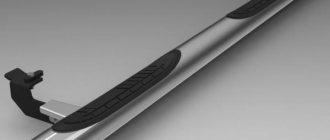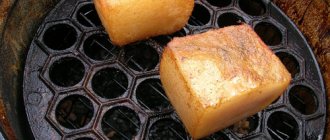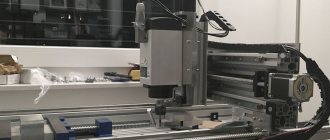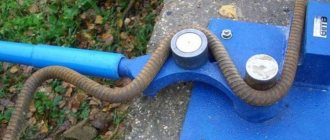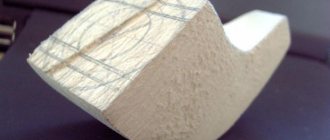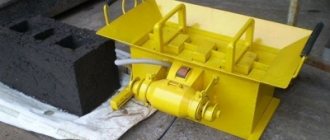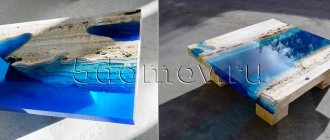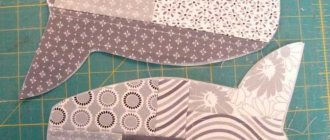Stone cutting machines with free abrasive have a number of advantages over machines with diamond cutting wheels. Abrasive options are cheaper and can be used for cutting large stones. The only drawback is that the cutting process is slower than using diamond blades.
Machines with free abrasives are:
- With disc-shaped canvases
- With ribbons
- With wire panels
What follows is a complex classification of the above machines. But we'll leave it out. Let's take a better look at the typical options for stone cutting machines.
Wire based machine
The machine using wire to cut stone is still being rapidly used in many countries. The main advantage of using this machine is that the size of the stone to be cut is practically unlimited. There is only a limitation on the size of the arc onto which the wire is stretched.
We hope that this article will be useful to you, dear readers. Thank you for your attention!
Last summer was quite productive in terms of various crafts. All summer we worked on three projects at once: a new model of a ski lift, a generator and a stone-cutting machine. Today I’ll tell you about the stone-cutting machine. This machine is necessary for my brother, who is seriously interested in petrified trees. In the future, this machine will be intended for sawing petrified trees.
Before starting work, I had photographs of similar machines at my disposal, and I was able to visit a stone-cutting workshop, where they showed me a working machine. I had a good idea of the structure and operating principle of this machine, and thought through the design of a homemade machine. I wanted to make a convenient and compact machine, and I think it worked out in the end.
My brother already had some work: a single-phase motor with a power of 0.75 kW was purchased, a hub for bearings and a shaft was machined. The engine and hub were located on the same platform.
The hub was made with a large margin of safety, and as a result it had considerable dimensions. Because of this, a significant part of the saw blade is “eaten up,” and large-diameter blades are expensive. I decided to make a hub of my own design, using UCP-205 housing bearings. These bearings have proven themselves in ski lift operation.
The frame is welded from corners and a rectangular profile. The frame resembles a rectangular parallelepiped. Overall frame dimensions 600*400 mm. After making the frame, I cut blanks from 3mm sheet iron for the future water tank. The water tank is designed to cool the saw blade.
The final layout of the machine components has begun.
True, during the work we had to cut off one stand, since it interfered with the electric motor pulley. Later the stand was replaced with a corner. And in general, the racks could also be made from corners. After carrying out the basic welding and assembly work, the future machine looked like this.
Read also: Development of a welding process
As I wrote above, UCP-205 housing bearings were used in the hub. The shaft is machined from the axle shaft of a ZIL-157 car. True, the workpiece had to be annealed; the lathe was too tough for such an axis. Then I immediately remembered Soviet quality.
Having made the necessary calculations, I came to the conclusion that the engine speed would be enough to cut stone and the disk would not fly apart, so the gearing was 1:1. A three-strand aluminum pulley for the walk-behind tractor engine shaft was purchased. From this pulley two pulleys were made for a stone cutting machine.
The machine table top is made of 3 mm sheet iron. The tabletop is attached to the frame using 17 M6 bolts. The bottles have a countersunk head, and holes of the required diameter and depth are drilled on the tabletop, thanks to which the caps are not exposed above the surface.
This is what the machine looked like after the first painting. Painting using an aerosol can.
The side walls of the machine are covered with a stainless steel mesh with a fine mesh. The mesh is fixed with aluminum angles and M6 bolts.
The most important moment has come - testing the machine. Photos and videos show the first cutting of petrified wood on this stone cutting machine.
There are minor modifications to be made: installation of a protective canopy over the saw blade, installation of a protective casing for the electric motor. Don’t forget about grounding when working with this machine; after all, there is water next to the engine.
During the first test, it turned out that only a little water needs to be poured into the tank so that the saw blade goes 5-10 mm into the water, otherwise there is a strong splash of water and working on the machine becomes dangerous. Using this stone-cutting machine, using a large saw blade, you can cut workpieces up to 90 mm thick. The water tank is removable, this is necessary for washing the tank from residual stone particles.
To obtain a stone of a given size, a stone-cutting machine is used. Such equipment allows you to process durable materials and at the same time maintain their integrity. If you often do stone work at home, that is, processing, then you are unlikely to be able to do without such equipment. Nevertheless, it is not at all necessary to buy it, because you can try to assemble the machine from scrap materials, but if something is missing, you can always buy more, it will still be cheaper.
Brick cutting machine design
The design of the machine looks like a circular saw, only in smaller sizes. Of course, there are differences in how the cutting blade is mounted.
When designing a machine, you can use existing diagrams and drawings with exact dimensions.
Or you can create something fundamentally different from others, according to your own ideas and calculations. The main thing is that the resulting result does its job and is safe to maintain.
The machine consists of:
- The disc itself on the engine, or a fixed angle grinder.
- Carriages, that is, the moving part on which the brick is laid for cutting.
- A fixed frame to which the entire structure of the machine is attached.
You can attach legs to the machine, or you can fix it on any place convenient for this (table, workbench, etc.).
In addition, some craftsmen prefer to work on a machine using water. To prevent brick dust from scattering throughout the room.
If you think the same, then you should think in advance about the mechanisms for supplying water to the cutting site.
General information
Stone-cutting equipment, despite its simplicity, is quite complex, so before assembly you need to familiarize yourself with the theory. A diamond blade is used to cut the stone. The advantage of this solution is that, unlike a conventional one, it is more durable and durable. In general, all diamond equipment in construction is gradually occupying its niche, displacing classical tools. Apparently there are reasons for this.
So, you can make a stone-cutting machine with your own hands, but you need to understand that equipment of this type must have a number of mandatory qualities. Firstly, job security. Since we will be dealing with high-speed equipment, we need to pay special attention to this point. Secondly, reliability and quality. The tool should work for a long time and cut efficiently, remember this.
Main types and purpose
Stone cutting machines have different configurations, equipment and are divided into the following types according to purpose:
- Stone splitters: designed for producing facing stones and paving stones with a relief split structure.
- Calibrating: used for leveling and processing the surface of stone slabs.
- Cutting machines are widely used. They are used for cutting stone into pieces of the required size and giving them the required shape.
This is interesting! Manual and electric tile cutters are the simplest type of cutting machine.
Machines operating on the principle of waterjet cutting are placed in a separate category. As a rule, they have numerical control, which allows using a computer program and a controlled abrasive-liquid jet to produce a shaped product from a stone blank. In particular, such machines are used for the manufacture and finishing of products of complex shapes and artistic cutting of stone.
Main elements of the machine
The unit consists of several working units. They can be called classic. The fact is that the same units are used in any other equipment where rotational motion takes place. We have a shaft onto which the cutting disc is mounted. In addition, a pulley and a belt are needed to transmit rotational motion. Consequently, the transmission will be belt-driven; perhaps this is not the best solution, but clearly the most economical. If it breaks, it can be easily repaired by replacing the belt or pulley. The shaft is connected to the electric motor by transmission.
Read also: Adapter from oxygen cylinder to reducer
In principle, these are all the working parts of a stone-cutting machine. Of course, if you are planning to make it yourself, then you need to take care of a flat platform on which the material to be processed will be placed.
Why do you need a machine?
This tool is used to create your own material for constructing various buildings. Thus, by purchasing a machine for making bricks, a person can make the materials for construction himself. First of all, this is necessary in order to save money during construction. Building materials are quite expensive, but the machine allows you to produce them using expensive raw materials without extra costs. But it is worth remembering that different types of materials are needed for different buildings. Thus, sand-lime brick is not waterproof, and therefore cannot be used to create pipes and plinths. Therefore, firing will be required.
Operating principle of the equipment
We can say that the essence of the work is not much different from a machine for cutting wood. The key differences are the shape and material of the disc, and the presence of a cooling system on the stone-cutting equipment. But despite this, you need to understand that stone is much stronger than any type of wood, so it is simply necessary to familiarize yourself with the general instructions for working with such equipment.
A diamond saw is a productive thing; it is capable of sawing stone at 0.5 cm per second, which is quite fast. The greater the strength and toughness of the material, the lower the cutting speed and its depth. It is also worth considering that holding the stone while working is not very convenient and unsafe. Therefore, special clamps sliding towards the cut are used. They eliminate shaking and rotation of the workpiece during processing. The feed should be so slow and smooth that there is minimal contact between the blade and the stone.
Features of equipment with free abrasive
Machines with free abrasive include all stone-cutting equipment in which the cutting tool is not rigidly fixed to the frame: a disk blade, a belt blade, as well as a wire-type cutting element. A distinctive feature of machines with free abrasive is the possibility of vertical and/or perpendicular movement of the working tool relative to the bed.
The advantages of such stone-cutting equipment include its lower cost. In addition, such machines can be used for sawing and primary processing of fairly large blocks, without the need to move the blocks themselves. The disadvantages of machines with a free working element include the low speed of stone processing and cutting.
Making a stone-cutting machine with your own hands: stage one
Before proceeding directly to the assembly, we will need to acquire the necessary tools and materials. In principle, it is better to first decide on the engine. It can be removed from an old washing machine or bought used. Typically, a power of 180-250 watts is quite enough to work with stone. Such a motor can develop about 1,500 rpm. It is extremely important to choose the right pulley. It is desirable that it be two-stage with a gear ratio of 1:1. A gear ratio of 1:0.35 is also acceptable. In this case, it will be convenient to work with bulk abrasive, and in the case of 1:1 - with fixed abrasive.
Where can I get such a belt? It can be removed from the Zaporozhets car, where it is wedge-shaped and ideal for our task. The faceplate mounting thread can be either right-handed or left-handed, which is not of fundamental importance. The main thing is that during operation it does not fly off the axis.
Do-it-yourself tile cutter: mechanical and electric from an angle grinder
When laying ceramic tiles, it is often necessary to cut them to obtain pieces of the desired size. Professional layers use tile cutters for this purpose that cost several thousand rubles. If renovations in an apartment are carried out on your own, it is not profitable to purchase an expensive device for cutting 15-20 tiles. The article will tell you how to make a tile cutter with your own hands from common parts and mechanisms.
Types of tile cutters
There are two main types of tile cutters:
- Mechanical devices. They are a structure of two parallel pipes along which the cutting element moves (roller made of hard alloys, rings coated with diamond, etc.). Rolling with force along the surface, the roller cuts the tile to its entire length, and it easily breaks when pressed. The result depends on the sharpness of the video and the experience of the master. Not suitable for cutting tiles with marble or granite chips.
- Electrical devices that cut tiles with special saws or abrasive wheels. Allows you to get an even cut even in hard tiles. The quality of the cut depends on the material of the cutting wheel, the speed of its rotation, and the cooling of the cutting area.
Mechanical homemade tile cutter
It does not require a lot of time and parts to make, as it has a manual format.
- a handle from an old hammer drill or drill;
- metal corner 30x30 with 8 mm holes;
- 2 nuts 8 mm;
- 1 x 6mm self-locking nut with nylon ring;
- washer 6 mm;
- bolt 6 mm, length 30 mm;
- bolt 8 mm, length 60 mm;
- cutting roller from a tile cutter (new or used);
- wrenches of the required size.
- Insert an 8 mm bolt from the inside of the angle into the hole and tighten with a nut on the other side.
- Screw the nut along the thread 2-3 cm from the edge of the bolt.
- Screw the bolt into the handle from the hammer drill to the level of the nut and tighten.
- From the outside of the second side of the angle, insert a 6 mm bolt into the hole.
- Place a cutting roller on the inside of the bolt, then a washer.
- Screw a nut with a nylon ring onto the bolt and tighten it so that the cutting roller rotates without play.
Electric homemade tile cutter
Making an electric tile cutter does not require special technical knowledge and skills. At some stages, welding work is necessary, but its volume is small.
- Bulgarian. It is necessary to use the tool without damage to the housing, signs of electrical short circuit, etc.
- Metal plates 5 mm thick measuring approximately 15 by 6 cm.
- A metal ring 2 cm wide with an internal diameter equal to the diameter of the support flange of the angle grinder. It can be cut from a suitable pipe.
- Textolite sheet 30x20 cm 2-3 cm thick for the base of the tile cutter.
- 3 bolts 10 mm, 4 nuts 10 mm, self-tapping screws (the size is selected during manufacturing).
- Metal processing tools (files, grinder, etc.)
- Electric drill, screwdriver, metal drills of various diameters.
- Electric welding machine.
The task of modernization is to create a rocker mechanism, on one shoulder of which a grinder is attached. The angle grinder moves, describing part of a circle, the center of which is the axis of the rocker arm. The amplitude of movement is limited to 3 cm above the base and 3 cm below the base. This is enough to cut tiles of any thickness.
- The following parts are cut out from metal plates (with a hacksaw or grinder):
- 3 pcs. size 40x45 mm. One of the 40 mm sides is ground in the form of a semicircle so that after installation the corners do not interfere with the rotation of the rocker around the axis. A 10 mm hole is drilled in the center of the plates;
- 1 PC. 40x100 mm in size - the lower part of the rocker mechanism, which will be bolted to the textolite base of the tile cutter. To do this, two holes with a diameter of 10 mm are made;
- 1 PC. 40x80 mm in size - the top of the swinging mechanism;
- 1 PC. irregular L-shaped. This is the lever of the rocker mechanism. The grinder will be attached to the elongated part. The opposite side will be pushed through the drilled hole onto the central axis.
- A section of approximately 1 cm is cut out in the metal ring that will be put on the support flange. A 10 mm nut is welded on the outside of the ring at both ends of the removed section so that a bolt can be screwed through them. Tip: It’s easier to weld nuts on with the bolt already screwed in. The result is a clamp - when the bolt is tightened, the ring tightens.
- The clamp is welded to the edge of the long side of the L-shaped part.
- The metal parts are put on the central axis (10 mm bolt), tightened with a nut and welded so that the rocker arm with the clamp ring can rotate around the axis.
- The rocker mechanism is screwed to the textolite base through the holes in the lower part.
- The clamp ring is put on the supporting flange of the angle grinder. The position of the angle grinder that is most convenient for work is selected. The clamp is tightened, fixing the tool. The abrasive wheel should not touch the edge of the textolite base. A protective shield is installed on top and secured by welding.
- A small hook or corner with a hole is welded to the top cover of the rocker mechanism. A spring about 5 cm long in a compressed state is attached to it. It is tensioned so that the grinder takes a position in which the bottom of the cutting wheel is higher than the base. The second end of the spring is also attached to the hole in a small corner, which is fixed to the PCB with a screw.
The electric tile cutter is ready. They saw with it, moving the tool along the cutting line.
Additional upgrade
The tool can be supplemented with a dust collector. To do this, a groove about 4 cm wide and 1 cm deep is made from the bottom side of the textolite base. It starts next to the edge of the cutting wheel and ends on the opposite side of the base, a few centimeters before the edge. A hole with a diameter of 3–4 cm is drilled in this place. A metal plate with a hole is attached to it using screws on top, to which an adapter 4–5 cm long, cut from a metal pipe, is welded. The diameter of the pipe is equal to the internal diameter of the vacuum cleaner air duct, which is put on the adapter. Now, when you turn on the vacuum cleaner, all dust will be sucked out from the work area.
You can make a simple guide device for a tile cutter, thanks to which the accuracy and quality of the resulting cut will increase significantly. For this, a metal plaster rule of the required length is used. It is secured to the tile using clamps (double-sided construction tape will also work) at the required distance to the cutting line. Resting against the smooth edge of the rule, the tile cutter moves along it and makes a perfectly straight cut.
We continue to carry out work
It is necessary to find a suitable container for collecting sludge. This can be any trough that you find in your workshop. Next, we make a table on which the workpiece will be placed, and install pressure plates along the guides. We place the electric motor under the table on a special panel. Using a belt drive, we connect it to the shaft on which the working part of the tool is mounted.
Any tabletop stone-cutting machine must be manufactured accurately and with high quality. The hole in the table for the saw should be at least 5 mm larger than its diameter. This will be quite enough for its smooth operation. By the way, don’t forget to connect an electric pump that will supply water to the workpiece. To do this, you can take the most ordinary electric pump (say, a car pump) and a suitable container. All this is installed correctly. All that remains is to check the reliability of fastening the disk and threaded connections, after which you can begin a test run of the equipment.
Manta stone cutting machines
If the desire to make something yourself is not as great as you would like, then you can always buy ready-made equipment. But here it is extremely important to choose the right manufacturer, on which both the build quality and, in fact, the cost depend. Now I would like to talk about the products of the Italian manufacturer, in particular about.
Read also: Shaft steel 45 GOST 1050 88
For example, MANTA 85/220V is the cheapest machine of all offered. The cost of such an installation is about 100,000 rubles. In return, you will receive powerful and very productive equipment. We are talking about a 2.2 kW motor, which, of course, cannot be compared with a washing machine motor. The maximum cutting length is about 850 mm, and this allows you to process very large workpieces. The maximum disc rotation speed is 2,200 rpm, which is suitable for both artificial and natural minerals. The machine allows you to work with stone, the thickness of which reaches 180 mm, while the work is performed at an angle of 90 and 45 degrees relative to the table, which is very convenient.
DIAM machines
Now let's look at something cheaper. The SK-600/2.2 machine is just that. The price for finished equipment is 45-50 thousand rubles, which is two times less than in the previous case. In return, you will receive a unit with an engine power of 2.2 kW, which, as we have already figured out, is quite a lot. The maximum cutting depth and length are 115 and 600 mm respectively. It is possible to perform work at disk rotation speeds of up to 2,800 rpm.
This is not to say that SK-600/2.2 will cope with any task, but processing of facing materials, tiles, etc. he can do it. The key features of the model are its small dimensions, which allows it to be easily and quickly moved from place to place. In addition, this type of stone cutting machine is very easy to operate.
How to choose a model?
If a tool for cutting bricks is needed only for home use, then you should pay attention to a manual machine.
This is the simplest model that does not require large manufacturing costs. It can be done by every man who has welding skills. But it is worth remembering that the productivity of such equipment is low. Therefore, if a tool for hyper-pressed bricks is needed for the development of a small construction business, then it is better to make or purchase a semi-automatic or fully automated machine with hyper-pressing.
About other machines: Machines and emery for sharpening tools and knives Special buy in Rostov-on-Don: low prices, delivery
If the choice fell on an automated unit, then you should take care of an operator who will constantly be near it.
When choosing, you should also pay attention to performance and working pressure. The output depends on the size of the zone on which the bricks are formed: the matrix can consist of 1 and up to 8 units. For high-quality production, a high working pressure is needed, but in manual machines it reaches only up to 2 tons. Such automatic tools will help to produce materials for cladding or for light buildings. But when purchasing an automated machine, it is worth remembering that its maintenance requires an operator who will monitor the operation of the equipment.
Consumer Reviews
In many cases, it makes sense to read consumer advice and reviews before purchasing any tool. The fact is that sometimes expensive equipment, although of high quality, has worthy analogues from other, less well-known companies with a lower cost. In any case, consider this information before purchasing a stone cutting machine. Reviews, by the way, can also suggest how to upgrade equipment made by yourself. For example, many users say that it is convenient to place the saw not in the table, but above it, on a special guide, which certainly makes sense.
Models and types
Automated devices have maximum productivity.
Types of brick machines:
- lightweight manual;
- middle category;
- automated.
A stone-cutting machine for making bricks of the first type is considered ineffective. Its productivity is only 1000 units of material in 8 hours. The average quality model produces about 2,000 bricks. Fully automated tools make up to 6,000 materials in 8 hours. Suppliers are countries such as Russia, China, Italy, Spain. There are such models, whose characteristics are described in the table:
About other machines: Drilling and cutting lathes buy in Moscow
